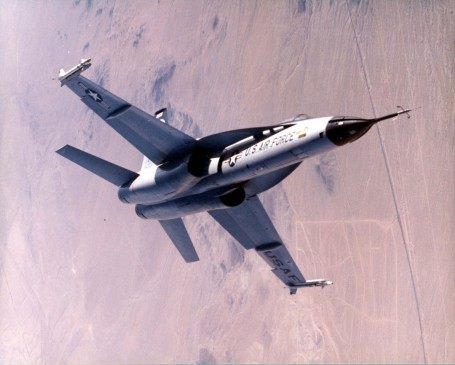Thirty-eight years ago this month, the No. 1 USAF/Northrop YF-17 Cobra Lightweight Fighter (LWF) prototype made its maiden flight from Edwards Air Force Base, California. Northrop Chief Test Pilot Henry E. “Hank” Chouteau was at the controls of the agile twin-engine jet.
The Lightweight Fighter (LWF) Technology Program was a United States Air Force (USAF) effort to develop a reduced-cost, highly maneuverable combat aircraft. The LWF Program, which began in 1971, ultimately resulted in a competitive fly-off between the Northrup YF-17 and General Dynamics YF-16 in 1974.
The Northrop YF-17 Cobra measured 56 ft in length and had a wingspan of 35 ft. Gross Take-Off Weight (GTOW) was 34,280 lbs. Power was provided by twin General Electric YJ101-100 afterburning turbofans, each generating 14,400 lbs of thrust. The aircraft had a maximum design speed of Mach 1.95, an unrefueled range of 2,600 nm and a service ceiling of 50,000 ft.
The accent on agility and maneuverability led designers to configure the YF-17 with leading edge strakes and twin vertical tails. The leading edge strakes helped alleviate asymmetric vortex shedding and the associated induced yawing moment at high angle-of-attack. Similarly, the twin vertical tails provided enhanced directional stability at high angle-of-attack flight conditions.
YF-17 Ship No. 1 (S/N 72-1569) first took to the air on Sunday, 09 June 1974. The aircraft displayed impressive performance, agility and handling qualitities. On Tuesday, 11 June 1974, the Cobra exceeded the speed of sound in level flight. This marked the first time in United States aviation history that an aircraft did so without using afterburner.
On Wednesday, 21 August 1974, YF-17 Ship No. 2 (72-1570) joined the Northrop LWF flight test force. Together, these two airframes flew 288 flight test sorties for a total of 345 flight hours. During the test program, the Cobra hit Mach 1.95, pulled 9.4 g’s and achieved a maximum altitude beyond 50,000 ft. The jet handled like a dream and lived-up to its advance billing in virtually every way.
Despite the YF-17’s great promise, it did not win the LWF fly-off with the YF-16. Competitions of this sort are often between equals and the final decision can go either way. Nuanced political factors and the like often determine the final outcome. Such was the case in this situation. Both aircraft were exceptional, but only one could be declared the winner.
Happily for American aviation, the YF-17 story did not end with the LWF loss. Indeed, the YF-17’s merits were so obvious to the aviation community that it received new life with the United States Navy. In May of 1975, the team of Northrop and McDonnell Douglas secured the Navy Air Combat Fighter (NAVF) contract to produce a remarkable aircraft that was a direct descendant of the YF-17 Cobra. We know that aircraft today as the F/A-18 Hornet.

